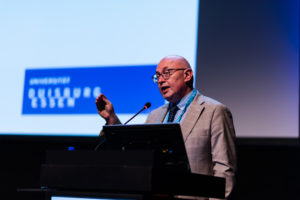By Tiu Vlad
Under the high patronage of C. Tassorelli (Pavia, Italy) and S. Evers (Münster, Germany), acting as speakers and chairpersons, this symposium focused on a rather uncomfortable topic – unmet needs in the management of migraine.
The session began with C. Tassorelli’s presentation on Refractory Migraine Attacks. An introduction to what exactly should we consider as refractory migraine was given, pointing out that more than 5% of migraine patients meet the current diagnostic criteria. Tassorelli pointed out that the burden of disability is tremendous for these patients. Their management is a difficult task, and our failure to control the symptoms demands an energetic attitude, targeting both triggers and aggravating factors, optimizing acute and preventive therapies, and pushing for new research to shed more light on the matter. New therapies targeting CGRP show great promise, but difficult cases will still require a multidisciplinary approach, with a dedicated follow-up, ideally performed by the same physician.
The second speaker, P. Pozo-Rosich from Barcelona, Spain, tackled the “Unmet Needs in the Treatment of High Frequency and Chronic Migraine Patients”. An emphasis was placed on the fact that episodic migraine with high frequency of attacks bears a similar burden on the patients as with chronic migraine.
We know now that more than 10 headache days leads to high disability however, we are still lacking in correctly treating these patients. 40% of episodic migraine patients should receive preventive therapy, while only 13% actually do, and out the 100% with chronic migraine that should be on preventive therapies, just 33% are.
Doctor Pozo-Rosich went on to highlight the main unmet needs and their possible solutions. In the need for efficacy, we mustn’t forget that treating with moderate efficacy is better than not treating at all, and that novel therapies show great promise for non-responders. The issues of tolerability seems to be much less of an issue when evaluating onabotulinumtoxin A and CGRP targeting mABS. Due to their specificity, they also tend to show a much better profile of safety and adherence. Due to all these advantages, reported patient satisfaction also tends to be much higher for these novel drugs.
 Z. Katsarava from Essen, Germany, followed with the topic of Medication-Overuse in Chronic Migraine. “Chronic migraine is not just more headache”, the speaker stated. The burden of disability to these patients and the risk of medication overuse headache (MOH) is higher, while also frequently having other comorbidities as well– depression, anxiety, back pain, and so forth.
Z. Katsarava from Essen, Germany, followed with the topic of Medication-Overuse in Chronic Migraine. “Chronic migraine is not just more headache”, the speaker stated. The burden of disability to these patients and the risk of medication overuse headache (MOH) is higher, while also frequently having other comorbidities as well– depression, anxiety, back pain, and so forth.
Fortunately, he stated, not all that overuse medication get MOH. For the ones that do, it’s clear that a central sensitization mechanism is at play. Whether the triggers are endogenous, stress related or due to medication overuse by itself, a wider approach may prove beneficial. As a conclusion, the audience was reminded that, sometimes, simply managing the acute medication might prove to be a very powerful tool.
The last presentation of this session came from S. Evers, from Münster, Germany. New insight was gained following his approach on rare migraine syndromes. A brief review of the cyclical vomiting syndrome, abdominal migraine, benign paroxysmal vertigo, benign paroxysmal torticollis, infantile colics, alternating hemiplegia of childhood and, lastly, Alice in wonderland syndrome, showed the complexity of these syndromes and how they relate to the pathophysiology of migraine. Doctor Evers pointed out that diagnostic criteria are usually not very well known, and that most of the treatment options are based on case studies and empirical observations rather than RCTs. The link between these syndromes and migraine is not yet fully understood, although it is believed that perhaps CGRP may play a role in it.
This symposium was supported by an educational grant from Eli Lilly.













